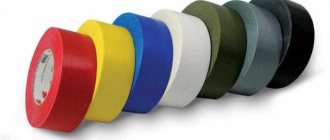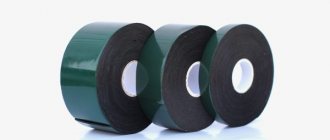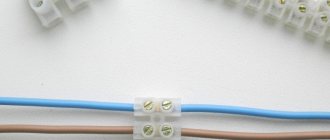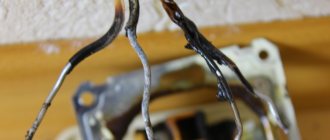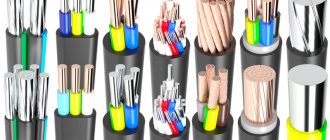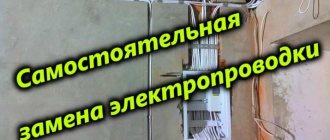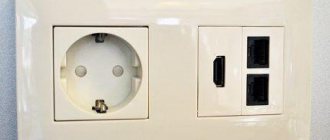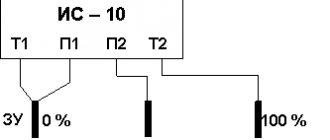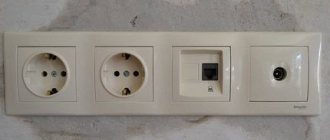Characteristics of electrical materials
The main characteristic in electrical engineering is the specific electrical conductivity, measured in S/m. It serves as a coefficient of proportionality between the field strength vector and the current density. Often denoted by the Greek letter gamma γ. Specific resistance is recognized as the reciprocal of electrical conductivity. As a result, the formula mentioned above takes the form: current density is directly proportional to the field strength and inversely proportional to the resistivity of the medium. The unit of measurement becomes Ohm m.
The concept under consideration remains relevant not only for solid media. For example, electrolyte liquids and ionized gases conduct current. Consequently, in each case it is permissible to introduce the concept of resistivity, because an electric charge passes through the medium. Finding values in reference books, for example, for a welding arc is difficult for a simple reason - such tasks are not sufficiently addressed. This is not required. A century passed from the moment Davy discovered the heating of a platinum plate with an electric current until the introduction of incandescent light bulbs into everyday life - for a similar reason, the importance and significance of the discovery was not immediately realized.
Material property
Depending on the value of the resistivity, materials are divided:
- For conductors - less than 1/10000 Ohm m.
- Dielectrics have over 100 million ohm m.
- Semiconductors in terms of resistivity values are between dielectrics and conductors.
These values characterize solely the body’s ability to resist the passage of electric current and do not affect other aspects (elasticity, heat resistance). For example, magnetic materials are conductors, dielectrics and semiconductors.
How conductivity is formed in a material
In modern physics, resistance and conductivity are usually explained by the band theory. It is applicable to solid crystalline bodies whose lattice atoms are assumed to be stationary. According to this concept, the energy of electrons and other types of charge carriers is determined by established rules. There are three main zones inherent in the material:
- The valence band contains electrons bound to atoms. In this region, the electron energy is graded in steps, and the number of levels is limited. The outermost layer of the atom.
- Prohibited area. Charge carriers are not allowed to be in this region. Serves as the boundary between two other zones. Metals are often absent.
- The free zone is located above the previous two. Here electrons participate freely in the creation of electric current, and the energy is any. No levels.
Dielectrics are characterized by the highest location of the free zone. Under any natural conditions imaginable on Earth, materials do not conduct electric current. The width of the forbidden zone is also large. Metals have a lot of free electrons. And the valence band is simultaneously considered a conduction region - there are no forbidden states. As a result, such materials have low resistivity.
Calculation of beats resistance
At the interface of atomic contacts, intermediate energy levels are formed, and unusual effects used in semiconductor physics arise. Heterogeneities are created deliberately by the introduction of impurities (acceptors and donors). As a result, new energy states are formed, which exhibit new properties during the flow of electric current that the original material did not possess.
Semiconductors have a small band gap. Under the influence of external forces, electrons are able to leave the valence region. The cause is electrical voltage, heating, radiation, and other types of influences. In dielectrics and semiconductors, as the temperature decreases, electrons move to lower levels, as a result, the valence band is filled, and the conduction band remains free. Electric current does not flow. In accordance with quantum theory, the class of semiconductors is characterized as materials with a band gap of less than 3 eV.
Fermi energy
Fermi energy occupies an important place in the theory of conductivity and explanations of phenomena occurring in semiconductors. Adding to the secrecy is the vague definition of the term in the literature. Foreign literature says that the Fermi level is a certain value in eV, and the Fermi energy is the difference between it and the smallest one in the crystal. Here are selected general and understandable proposals:
- The Fermi level is the maximum of all those inherent to an electron in metals at a temperature of 0 K. Therefore, the Fermi energy is considered to be the difference between this figure and the minimum level at absolute zero.
- Fermi energy level - the probability of finding electrons is 50% at all temperatures except absolute zero.
The Fermi energy is determined exclusively for a temperature of 0 K, while the level exists under any conditions. In thermodynamics, the concept characterizes the total chemical potential of all electrons. The Fermi level is defined as the work required to add a single electron to an object. The parameter determines the conductivity of the material and helps to understand the physics of semiconductors.
The Fermi level does not necessarily exist physically. There are known cases when the location was in the middle of the forbidden zone. Physically, the level does not exist; there are no electrons there. However, the parameter is noticeable using a voltmeter: the potential difference between two points in the circuit (readings on the display) is proportional to the difference in the Fermi levels of these points and inversely proportional to the charge of the electron. Simple addiction. It is permissible to link these parameters with conductivity and resistivity using Ohm’s law for a section of the circuit.
Low resistivity materials
Conductors include most metals, graphite, and electrolytes. Such materials have low resistivity. In metals, positively charged ions form lattice sites surrounded by a cloud of electrons. They are usually called common because they are part of the conduction band.
Although it is not entirely clear what an electron is, it is usually described as a particle moving inside a crystal with a thermal speed of hundreds of km/s. This is much more than is needed to put a spacecraft into orbit. At the same time, the drift speed, which forms an electric current under the influence of the voltage vector, barely reaches a centimeter per minute. The field propagates in the medium at the speed of light (100 thousand km/s).
As a result of these relationships, it becomes possible to express specific conductivity through physical quantities (see figure):
Formula for calculations
- Electron charge, e.
- Free carrier concentration, n.
- Electron mass, me.
- Thermal speed of carriers,
- Electron mean free path, l.
The Fermi level for metals lies in the range of 3 – 15 eV, and the concentration of free carriers is almost independent of temperature. Therefore, specific conductivity, and therefore resistance, is determined by the structure of the molecular lattice and its closeness to the ideal, freedom from defects. The parameters determine the mean free path of electrons; they are easy to find in reference books if you need to make calculations (for example, to determine resistivity).
Metals with a cubic lattice have the best conductivity. This also includes copper. Transition metals are characterized by much higher resistivity. Conductivity decreases with increasing temperature and at high AC frequencies. In the latter case, a skin effect is observed. The dependence on temperature is linear above a certain limit named after the Dutch physicist Peter Debye.
Not so straightforward dependencies are also noted. For example, heat treatment of steel increases the number of defects, which naturally reduces the specific conductivity of the material. The exception to the rule was annealing. The process reduces the density of defects, due to which the resistivity decreases. Deformation has a clear effect. For some alloys, mechanical processing leads to a noticeable increase in resistivity.
Volume representation of a property
Basics of electroacoustics
Conducting materials Solid conductors of electric current are metals, metal alloys and some modifications of carbon. Among metal conductors there are: materials with high conductivity, which are used for the manufacture of wires and cables; conductive connections in microcircuits, transformer windings, waveguides, etc.; metals and alloys with high resistance, which are used for the manufacture of electric heating devices, resistors, rheostats for incandescent lamps, etc.
Properties of conductor materials. The main electrical parameters of conductor materials are
- specific conductivity (or its inverse value - resistivity)
- temperature coefficient of resistivity.
The mechanical properties of conductors are characterized by tensile strength and elongation at break. Such physical parameters as density, melting point, etc. are well known.
The resistivity p of a conductor having a constant cross-section S and length l is determined by the formula p = RS/l and is expressed in ohms per meter (Ohm-m). To measure the resistivity of conductors, the non-system unit Ohm-mm2/m is used (S is measured in mm2, l - in m); 1 Ohm-m=106 Ohm-mm2/m. Fractional of the system unit 1 μΩ-m = 1 Ω-mm2/m. We will express the resistivity of the conductors in µOhm-m, while maintaining the usual numerical values p.
The temperature coefficient of resistivity shows how a resistance of 1 ohm changes with a change in temperature of one degree. The physical parameters of semiconductor materials are given in table. 1.
| Metal | Density, Mg/m3 | Temperature, melting point, °C | Resistivity, µOhm-m | Temperature coefficient specific resistance. | work function, eV |
| Aluminum | 2,7 | 660 | 0,0265 | 4,1 | 4,25 |
| Tungsten | 19,3 | 3400 | 0,055 | 5,0 | 4,54 |
| Iron | 7,87 | 1540 | 0,097 | 6,25 | 4,31 |
| Gold | 19,3 | 1063 | 0,0225 | 3,95 | 4,3 |
| Cobalt | 8,85 | 1500 | 0,064 | 6,0 | 4,41 |
| Copper | 8,92 | 1083 | 0,0168 | 4,3 | 4,4 |
| Molybdenum | 10,2 | 2620 | 0,05 | 4,33 | 4,3 |
| Nickel | 8,96 | 1453 | 0,068 | 6,7 | 4,5 |
| Tin | 7,29 | 232 | 0,113 | 4,5 | 4,38 |
| Platinum | 21,45 | 1770 | 0,098 | 3,9 | 5,32 |
| Mercury | 13,5 | — 39 | 0,958 | 0,9 | 4,52 |
| Lead | 11,34 | 327 | 0,190 | 4,2 | 4,0 |
| Silver | 10,49 | 961 | 0,016 | 4,1 | 4,3 |
| Chromium | 7,19 | 1900 | 0,13 | 2,4 | 4,58 |
| Zinc | 7,14 | 419 | 0,059 | 4,1 | 4,25 |
The resistivity of thin metal films (the thickness of which is commensurate with the electron mean free path) is greater than the resistivity of the original metal and depends on the thickness and method of producing the films. The conductive properties of thin films are assessed by the specific surface resistance (resistance of the square), equal to the resistance of a section of the film, the length of which is equal to its width when current passes through its two opposite faces parallel to the surface of the substrate Rп =рб/б, where Рb is the specific (volume) resistance of the film . The resistivity of alloys is greater than the resistivity of the original components. An increase in p occurs when non-metallic impurities are introduced into the metal, as well as when two metals are fused to form a solid solution in which atoms of one metal enter the crystal lattice of the other.
Technical conductor materials are divided into
- high conductivity materials,
- metals and alloys for various purposes,
- high resistance alloys,
- conducting modifications of carbon and materials based on them.
Materials of high electrical conductivity . The most common materials with high electrical conductivity include copper and aluminum (see Table 1).
Copper has low resistivity, high mechanical strength, satisfactory corrosion resistance, is easily soldered, welded and well processed, which allows it to be rolled into sheets, tape and drawn into wire.
Copper grades Ml and MO are used as conductor material. The Ml grade contains 99.9% pure copper, and in the total amount of impurities (0.1%) oxygen is up to 0.08%. “The second grade has the best mechanical properties, which contains 99.95% copper, and the impurities (0.05%) there is up to 0.02% oxygen. The best oxygen-free copper contains 99.97% pure substance, and vacuum (melted in vacuum induction furnaces) - 99.99. %. Hard-drawn copper, obtained by cold drawing, is used when high mechanical strength is required, and soft (annealed) copper is used when flexibility is important, for example, for the manufacture of installation wires and cords. Electrovacuum copper is used for the manufacture of parts for electronic devices. Copper is also used for the manufacture of foil getinax, and in microelectronics for the production of conductive films on substrates that provide connections between functional elements of the circuit. The most common brands of winding wires are given in table. 2.
| Wire brand | Insulation characteristics | Wire diameter, mm |
| PEL | Enamel varnish resistant | 0,02 — 2,44 |
| PEV-1 | Enamel with single and double viniflex coating | 0,06 — 2,44 |
| PALBO | Enamel paint-resistant with one layer of cotton winding | 0,2-2,1 |
| P-ELBD | The same, but with two layers of cotton winding | 0,72 — 2,1 |
| palsho | The same, but with one layer of silk winding | 0,05-2,1 |
| paleshd | Enamel varnish-resistant with two layers of silk winding | 0,86 |
| PELSHKO | Enamel paint-resistant with one layer of nylon winding | 0,05-2,1 |
| palshkd | Enamel paint-resistant with two layers of nylon winding | 0,86 |
| PELBV | Enamel paint-resistant with long-fiber paper wrapping | 0,51 — 1,45 |
| Air defense | One layer of cotton winding | 0,2 — 2,1 |
| PBD | Two layers of cotton winding | 0,2 — 5,2 |
Bronze is an alloy of copper with a small amount of tin, silicon, phosphorus, chromium, cadmium or other materials, which has higher mechanical properties than copper. Widely used for the manufacture of conductive springs. Brass is an alloy of copper with zinc and other additives, which has a high relative elongation, which is important when processing by stamping and deep drawing. Used for the manufacture of various conductive parts.
The composition and properties of some copper electrical alloys are given in Table. 3.Table 3
| Alloy | Specific conductivity,% to copper | Tensile strength, MPa | Elongation at break, % |
| Cadmium bronze (0.9% Cd) | 95 | Up to 310 | 50 |
| Bronze (0.8% Cd; 0.6% Sn) | 55 — 60 50—55 | 290 To 730 | 55 4 |
| Phosphor bronze (7% Sn; 0.1% P) | 10 — 15 | Up to 400 | 60 |
| Brass (70% Cu; 30% Zn) | 25 | 320 — 350 | 70 |
Aluminum is approximately 3.5 times lighter than copper. For electrical purposes, aluminum of technical purity AE is used, containing up to 0.5% impurities. A wire made of AE aluminum and annealed at a temperature of 350 °C has a resistivity of 0.028 μOhm*m. High-purity aluminum A97 (impurities up to 0.03%) is used for the manufacture of thin (up to 6 microns) foil, electrodes and housings of electrolytic capacitors.
Aldrey is an alloy of aluminum with magnesium (0.3 - 0.5%), silicon (0.4 - 0.7%). and iron (0.2 - 0.3%). It retains the lightness of pure aluminum (density 2.7 Mg/m3), has a resistivity close to it (0.0317 μOhm-m) and high (close to hard-drawn copper) mechanical strength.
Metals and alloys for various purposes . Below we consider metals and alloys used in electrical engineering and radio electronics. Based on the melting point, common characteristics and scope of application, refractory and noble metals, metals with medium and low melting points, solders and fluxes are distinguished.
Refractory metals have a melting point above 1700 °C, are chemically stable at low temperatures and active at high temperatures, therefore at elevated temperatures they are used in a vacuum or an atmosphere of inert gases. Refractory metals are tungsten, molybdenum, tantalum, niobium, chromium, vanadium, titanium, and zirconium. The main physical properties of some of them are given in table. 1. Refractory metals are used for the manufacture of filaments of incandescent lamps, electrodes in electronic lamps, film resistors in microcircuits, contacts that are highly resistant to erosion (electrical wear) and the formation of an electric arc. In addition to pure refractory metals, alloys W+Mo, Mo+Re, Ta+Nb, Ta+W, etc., which have the required ductility, electrical and thermal properties, are used in electric vacuum technology for instrument fittings.
The noble metals include the most chemically resistant metals (gold, silver, platinum).
Gold has high ductility (tensile strength 150 MPa, elongation at break about 40%) and is used in electronic technology for applying corrosion-resistant coatings to microwave resonators, internal surfaces of waveguides, lamp electrodes, etc. The main parameters of gold were given in table 1.
Silver is a metal that is resistant to oxidation (at normal temperature) and has the lowest resistivity (see Table 1). Used for the manufacture of electrodes and contacts for low currents, for direct application to dielectrics, internal surfaces of waveguides, as well as in the production of ceramic and mica capacitors.
Platinum is a metal that is very resistant to chemical reagents, can be machined well, and is ductile. The main parameters of the plugins are given in table. 1. Applicable to making thermocouples, pendants, moving electrometer systems and contact alloys.
Metals with an average melting point (iron, nickel, cobalt), which have a high temperature coefficient of resistivity (1.5 times higher than copper), are ferromagnetic.
Iron (steel) is the cheapest metal with high mechanical strength and relatively high (compared to copper) resistivity (about 0.1 μOhm-m). The resistivity of steel containing impurities of carbon and other elements increases
The conductor material used is mild steel containing 0.1 - 0.15% carbon, having a tensile strength of 700 - 750 MPa, elongation at break of 5 - 8% and a specific conductivity 6 - 7 times less than copper . The main parameters of iron were given in table. 1. Iron is used for the manufacture of housings for electronic devices operating at temperatures up to 500°C, at which gas evolution is low. Anodes, screens and other parts of electronic tubes are made from aluminized iron (coated with a thin film of aluminum).
Nickel has a density equal to that of copper, is easy to machine, and is resistant to oxidation. The main properties of nickel were given in table. 1. Used for the manufacture of fittings for electronic lamps, heating elements, as a component of magnetic and conductive alloys and protective coatings for iron products.
Alloys for electric vacuum devices are based on metals with average melting points. They have such temperature coefficients of linear expansion a1, at which it is possible to interface glass with metal structures of electronic devices.
Invar N-36 is an alloy of iron with 36% nickel, has a very low ag ~ 10-6K-1 in the temperature range from - 100 to + 100 ° C, Platinit N-47 is an alloy of iron with 47% nickel. Kovar is an alloy of iron with 29% nickel and 17% cobalt, has a low ai = 4.8 * 10-6 K-1 and a resistivity approximately 2 times lower than Invar. Melting point 1450°C. The alloys considered are used for the manufacture of current leads for electron tubes passing through glass elements.
Metals with low (less than 500 °C) melting point.
Lead is a soft, ductile metal with low strength (tensile strength 16 MPa, elongation at break 55%) and not resistant to vibration; resistant to water, sulfuric and hydrochloric acids and other reagents; exposed to nitric and acetic acids, lime and rotting organic matter. The main properties of lead were given in table. 1. Lead and its alloys are used for the manufacture of protective (from moisture) cable sheaths, fuse links, acid battery plates and as a material that absorbs x-ray radiation. Lead and its compounds are poisonous.
Tin is a soft, malleable metal, not affected by moisture, does not oxidize in air, and diluted acids act on it very slowly. The main properties of tin were given in table. 1. Used as protective coatings for metals (tinning), with an admixture of 15% lead and 1% antimony - to produce tin foil in the production of capacitors, is part of bronzes and alloys for soldering,
Mercury is a liquid, chemically resistant metal that interacts weakly with hydrogen and. nitrogen. Platinum, silver, gold, alkali and alkaline earth metals, zinc, tin and aluminum dissolve in mercury, forming amalgams. Tungsten, iron, tantalum are insoluble in mercury; Copper and nickel are slightly soluble. Mercury and its compounds are very poisonous. The main properties of mercury were given in table. 1. Mercury is used as a liquid cathode in mercury rectifiers, gas-discharge devices, fluorescent lamps, etc.
Solders are special alloys used in soldering. Solder typically has a lower melting point than the metals being joined. There are soft and hard solders with a melting point of TPL, respectively, up to 300 and more than 300 ° C.
Soft solders are tin-lead alloys (POS) with a tin content of 10 (POS 10) to 90% (POS 90), the rest is lead. Some tin-lead solders contain a small percentage of antimony (for example, POS 61-05). Hard solders are copper-zinc (PMC) and silver (PSR) solders with various “alloying” additives. The properties of some brands of soft solders are given in table. 4. Table 4
| Solder | Brand and composition | Melting temperature, cc | Specific resistance voltage, µOhm*M | Specific thermal conductivity, W/(m-K) | Tensile strength, MPa |
| Tin-lead | POS 61 (61% Sn; 39% Pb) POS 40 (40% Sn; 60% Pb) | 183 — 190 183 — 238 | 0,14 0,16 | 50 42 | 43 38 |
| Tin-lead-cadmium | POSC 50-18 (50% Sn; 18% Cd; 32% Pb) | 142 — 145 | 0,13 | 54 | 40 |
| Tin-lead-antimony | POSSu 40-2 (40% Sn; 2% Sb; 58% Pb) | 185 — 299 | 0,17 | 42 | 43 |
Fluxes used to obtain reliable soldering must dissolve and remove oxides and contaminants from the surface of the metals being soldered and protect them from oxidation. Acid-free fluxes are rosin, as well as fluxes based on it with the addition of inactive substances (alcohol, glycerin). Acid (active) fluxes are prepared on the basis of hydrochloric acid, chloride and fluoride metals, which actively dissolve oxide films on the surface of metals, thereby ensuring good adhesion and high mechanical strength of the joint. Soldering electrical appliances using active fluxes is not permitted.
High resistance alloys . Alloys with high resistivity are used for the manufacture of standard resistors, rheostats, hotplates, soldering irons, electrical measuring and electric heating devices and must withstand temperatures of about 1000 °C for a long time. The most widely used alloys are copper-based (manganin, constanten), chromium-nickel and iron-chromium-aluminium, the main properties of which are given in Table. 5.
Table 5
| Alloy | Density, mg/m" | Specific resistance, µOhm m | Temperature coefficient of resistance a -10e,k-1 | Operating temperature, °C | Tensile strength, MPa | Elongation at break, % |
| Manganin | 8,4 | 0.42 — 0,48 | 5 — 30 | 100 — 200 | 450 — 600 | 15 — 30 |
| Constantan | 8.9 | 0.48 — 0,52 | — (5 — 25) | 450 — 500 | 400 — 500 | 20 — 40 |
| Nichrome X15H60 | 8,2 | 1-1,2 | 100 — 200 | 1000 | 650 — 700 | 25 — 30 |
| Fechral and khromal | ||||||
| Х13У4 | 7,1-7,5 | 1.2 — 1,35 | 100 — 200 | 900 | 700 | 20 |
| Х23У5 | 6,9-7,3 | 1.3-1,5 | 65 | 1200 | 800 | 10-15 |
Manganin is a copper-based alloy (86% Cu, 12% Mn, 2% Ni) used for the manufacture of standard resistors and electrical measuring instruments. It is well drawn into wire with a diameter of up to 0.02 mm or rolled into a strip with a thickness of 0.01 - 1 mm and a width of 10 - 300 mm.
Constantan is an alloy of copper (60%) and nickel (40%). It lends itself well to processing (pulled into wire and rolled into a strip of the same dimensions as manganin). Electric heating elements made of constantan allow operation at temperatures up to 450° C. When heated, the wire is covered with an oxide film that has electrical insulating properties. When paired with copper or iron, constantan produces a large thermal emf, which makes it difficult to use resistors made from it in measuring circuits, but allows the manufacture thermocouples for measuring temperatures up to several hundred degrees.
Nichrome is an alloy of nickel (55 - 80%), chromium (15 - 20%), manganese (1.5%). Heat resistant in air. The service life of nichrome heating elements increases if they are placed in a solid inert environment that impedes the access of oxygen (for example, in clay - fireclay). Nichrome films deposited on substrates provide a square resistance Ro = 50-300 Ohms and dissipation power Pdop = 1 W/cm2 and are used as resistors in microcircuits.
Iron-chromium-nickel alloys (fechral, chromal) compared to nichrome have greater hardness and brittleness, are difficult to draw into wire and strip, have a lower cost and are used in powerful electric heating devices. . The resistive alloy RS-37-10 contains 36.5% Cr, 8 - 11% Ni, the rest is silicon, and PC30-01 - 32% Cr, 0.7 - 1.8% Fe, the rest is silicon. These alloys are respectively used for the manufacture of thin film and precision thin film resistors. Multicomponent resistive alloys MLT for thin-film resistors containing Si, Fe, Cr, Ni, Al, W are resistant to oxidation and chemically active environments. The main properties of resistive alloys are given in table. 6.
| Alloy | Density, mg/m | Melting point, °C | Specific resistance, µOhm-m | Temperature coefficient of resistance a*10-4, k-1 | Resistance of film square, Ohm | Film thickness, nm |
| RS-37-10 | 4,5 — 5 | 1250 | 5 — 7 | 15 — 25 | 50 — 2000 | 15 — 300 |
| RS-30-01 | 3,7 — 4 | 1350 | 25 — 35 | 5 — 15 | 800 — 3000 | 20 — 100 |
| MLT | — | — | 100 — 300 | From - 2.5 to + 4 | 100 — 20 000 | — |
Two-component materials for thin-film resistors of integrated circuits (molybdenum-chromium dislicides and silicon-chromium alloys) have the following parameters:
| MoSiz | CrSi2 | Si57Cr43 | Si73Cr27 | |
| R0, Ohm | 200 | 1300 | 2000 | 20000 |
| ar 10-4, K-1 | — 1,25 | +2 | — 1,5 | -14 |
Alloys - copel (56% Cu, 44% Ni); alumel (95% Ni, the rest Al, Si, Mg), chromel (90% Ni, 10% Cr), platinum-rhodium (90% Pt, 10% Rh) - used for the manufacture of thermocouples. To measure temperatures up to 1600 °C, platinum-rhodium-platinum thermocouples are used, up to 900 - 1000 °C - chromel-alumel, up to 600 °C - iron-copel, chromel-copel and iron-constant, and up to 350 °C - copper - constantan and copper-copel.
Conductive modifications of carbon. Natural graphite, pyrolytic carbon and carbon films are used as conductive materials in the manufacture of non-wire linear resistors, microphones and various parts of telephone network arresters, electric vacuum devices, etc.
Natural graphite is a modification of pure carbon; A finely dispersed type of carbon is soot. Pyrolytic carbon is obtained by thermal decomposition without oxygen (pyrolysis) of gaseous hydrocarbons (methane, gasoline) in a chamber.
Boron carbon films with a low resistivity coefficient (about 10 μOhm-m) and a temperature coefficient of 1 * 10-4 K-1 are obtained by pyrolysis of organoboron compounds, for example (C3H7)3B, etc. The main parameters of graphite and pyrolytic carbon are given in Table. 7.
Table 7
| Options | Polycrystalline graphite | Graphite monocrystal | Pyrolytic | |
| along | across | |||
| reference planes | ||||
| Density, Mg/m3 | 2,3 | 2,2 | 2,1 | |
| Temperature coefficient of linear expansion ai106, K-1 | 7,5 | 6,6 | 26 | 6,5 — 7 |
| Specific resistance, µOhm-m | 8 | 0,4 | 100 | 10 — 50 |
| Temperature coefficient of resistivity, K-1 | — 1*10-3 | +9-1 0-4 | -4- 10-2 | -2-10-4 |
High resistivity materials
Sometimes it is necessary to specifically increase the resistivity. A similar situation occurs in cases with heating devices and resistors in electronic circuits. That’s when it’s time for alloys with high resistivity (more than 0.3 μOhm m). When used as part of measuring instruments, there is a requirement for a minimum potential at the interface with the copper contact.
Nichrome is the most famous. Heating devices are often constructed from cheap fechral (fragile, but cheap). Depending on the purpose, the alloys include copper, manganese and other metals. This is an expensive pleasure. For example, a manganin resistor costs 30 cents on Aliexpress, where prices are traditionally lower than store prices. There is even an alloy of palladium and iridium. The price of the material should not be spoken out loud.
PCB resistors are often made from pure metals in the form of films by sputtering. Chromium, tantalum, tungsten, alloys, among other things, nichrome are widely used.
1.2. Low resistivity products
The materials considered are the basis of various electrical products: wires, tires, tapes, etc. Wires and cables are especially important in the repair of electrical equipment, so we will study them in more detail. • Winding wires - wire with particularly thin insulation with increased electrical and mechanical strength. They are produced in round and rectangular sections. In repair practice, winding wires with copper and aluminum conductors are mainly used. If in the stamp there is a letter “A” (APB) before the letter “P”, the wire core is aluminum; if “A” is not placed (PB), the wire core is copper. In addition, the brand characterizes the insulation of the winding wire, which can be: fibrous (PBD), enamel (PEV), combined (PEVSHO), at the same time organic (for example, cotton) and inorganic (for example, fiberglass). Fibrous wire insulations (PBD, APBBO, PShD, etc.), as a rule, have relatively high mechanical strength, but relatively low electrical strength, which is explained by the presence of air in the pores. Winding wires with such insulation are thicker than enamel insulation, but they are much cheaper than others. Enamel insulation of wires (PEL, PEV-1, PEVTL, etc.) with a small thickness has increased electrical strength. The wires are intended for mass use in the windings of electrical machines and transformers. Depending on the heat resistance class, the following brands are recommended: . class A and E-PEV-1, PEV-2, PEM-1, PEM-2, PETVL-1 and PETVL-2. And the PEV and PEM wire brands are practically equivalent in electrical insulating and physical-mechanical characteristics and do not require an additional layer of fiber insulation. Wires of the PEM brand are more resistant to transformer oil, they can also be recommended for the windings of electric machines of refrigeration units; grades of wires of class E: PETVL-1 and PETVL-2 are advisable to use only for windings of low-power electric motors; class B - PETV, PE-939, PETV-TS, their disadvantage is reduced resistance to short-term thermal overloads; class F—PET-155, PET, PEF-155. Of these, the PET-155 grade is most widely used in electrical machines, since it has good electrical insulating properties and resistance to thermal shock, but its mechanical characteristics are lower than, for example, the PETM grade. Brand PEF-155 has increased resistance to low temperatures. The weak mechanical strength of the insulation of many enameled wires (for example, PEL, PEV, etc.) required strengthening it by applying a layer of fiber insulation (PEL BO, PEVSHO, etc.) over the enamel film. If the threads do not stick to the enamel, they are glued with varnish. Combined wire insulation (enamel with thread) combines the positive qualities of enameled wires and fiber insulated wires. But usually they are thicker and more expensive. Wires with glass fiber insulation PSD (APSD), PSDK - two layers of glass filaments impregnated with glyphthalic and organosilicon varnishes, respectively, heat resistance classes of the former - F, and heat resistance classes of the latter - N. are also widely used for the manufacture of windings of electrical machines. Wires with combined insulation and with its reduced thickness PSDT, PSDKT and, finally, wires with a varnished surface PSD-L, PSDK-L. Power and installation wires with rubber and plastic insulation are used for the distribution of electrical energy in power and lighting networks. They are used outdoors and indoors; they can be laid openly, in pipes and under a layer of plaster. Designed to work with temperatures, °C: cores +65, ambient air +25, ground +15. With heat-resistant rubber based on butyl rubber, the operating temperature of the wire is allowed up to +85°C, with silicone rubber - up to +180°C. Wires are manufactured for rated voltages of 380, 660 and 3000 V. Wires are rubber insulated. PRN, APRN have copper and aluminum conductors with rubber insulation and an additional non-flammable rubber sheath. They are mainly used for laying in damp and dry rooms, as well as outdoors. PRGI is a wire with a copper, flexible conductor, with rubber insulation, which has protective properties. It is used for laying where increased elasticity is required, when installing connections of moving parts of electrical machines in dry and damp rooms. APPR is a wire with aluminum conductor and flame retardant rubber insulation, used for laying in residential and industrial buildings, in particular, livestock buildings. For lighting networks in dry and damp rooms, copper wires of the PRD brand in an unimpregnated braid, two-core and twisted, are used. Wires with plastic insulation. APV - aluminum conductor with polyvinyl chloride insulation, used for installation of power and lighting circuits in machines and machines, in pipes, fireproof building structures; PV1 - the same, but with a copper core; PVE - the same, but with a flexible copper core, used mainly for flexible installation with hidden and open installations. AVT - wire with aluminum conductors and insulation made of polyvinyl chloride plastic with a supporting cable for external installation (for example, in residential buildings or outbuildings in 380 V networks, in the 1st and II-M ice-covered regions. DVTU - the same, but with reinforced supporting cable for the 3rd and 4th regions of icy conditions. Used for laying in livestock buildings. Flexible (heat-resistant) power wires are used for electric motor leads. PVBL and RKGM grades have copper conductors, rubber insulation, but the first of them is made on the basis of butyl rubber , braided with lavsan thread, the second - made of silicone rubber, braided with fiberglass impregnated with enamel or heat-resistant varnish. • Connecting cords are used to connect power from the electrical network to various types of household current collectors: electrical machines, televisions, heating appliances, etc. Permissible operating heating temperature: with rubber insulation +65°C, with polyvinyl chloride plastic +70°C, rated voltage - up to 660 V. According to design, cords are divided into: flat without sheath (ShPP, PVP-1, ShVP-2), round without a shell (ShVPT), light with a shell (ShVVP, ShVL), ordinary with a shell (ShRO, ShRS, etc.). • Installation wires are intended for electrical connections in apparatus, instruments and other electrical devices, as well as circuits. They are divided according to heat resistance into conventional (MB, MP, MVKE) and increased resistance (MKR, MKTP, MPO), and the most heated point in the wire is taken as the basis. Copper conductors, tinned in many brands, single- and multi-wire, insulation: rubber, polyvinyl chloride plastic, polyethylene. Increasing the mechanical strength of the insulation is carried out by additional braiding (for example, with a nylon thread, the letter K is indicated in the brand), and shielding is also done in the form of a braid of copper wire (in the brand - E). Rated voltage 500, 1000 V for ordinary wires and 2, 2.5 and 4 kV for high-voltage installation wires type PVMP-2. Operating temperature for ordinary ones is up to +70°C, with polyvinyl chloride insulation - up to +85°C, with increased heat resistance - from +85 to +150°C. • Bare wires have found widespread use in overhead power lines. They are made of copper (one or several twisted wires (grade M)), aluminum (several twisted wires (A, Ap)), aluminum alloys (AN, AZh). To increase the mechanical strength of aluminum wires, they are reinforced with steel cores (steel-aluminum wires of the AC, ApS grades). Wires of grades A, Ap, AS, ApS, AN, AZh are recommended for use in rural, forest, mountainous areas, and are acceptable in the atmosphere of industrial areas; grade M - in the atmosphere of sea areas, as well as in industrial areas. Cables serve to transmit energy in electrical lines. They are conductive conductors isolated from each other with common insulation; they can have a lead or aluminum sheath and armor made of steel tapes or round galvanized steel wires, on top of which a protective cover is applied. The cores are made of single and multi-wire copper or aluminum. The insulation is made of paper impregnated with compounds, rubber, plastic. By application, cables are divided into power (for power supply to current collectors (AVVG, ASG, AAG)), control cables (for supplying low-power, low-voltage control signals to technical devices and retrieving information (KRSG, AKRVG)), controls, which differ from control cables only in design for appropriate conditions (KRSHU, KUPR), installation ones, the purpose of which is the same as the installation wires (KMPV, KMPEV). Based on voltage, they are divided into low-voltage with a rated voltage of up to 1 kV and high-voltage with a rated voltage of 1.6, 10, 20, 35 and more kV. • Contacts are the most vulnerable part of electrical networks; they serve to periodically reliably close and open circuits. In the process of performing these operations, they are exposed to an electric spark or arc, which causes erosion of surfaces, burning, even welding to each other, etc. Hence the requirements for contact materials: high electrical conductivity, refractoriness, hardness, good resistance to abrasion and arc exposure. For the manufacture of contacts, in addition to pure refractory metals, special alloys are widely used, which include silver, cobalt, copper, beryllium, nickel, chromium, molybdenum, tungsten, and cadmium. Contact products include brushes. • Solders. These are special materials that are melted at the joints of parts or to protect them from oxidation for coating them. Based on their melting temperature, solders are divided into soft and hard; they also differ in mechanical characteristics. Soft solders have a melting point of up to 400°C. They are used where connections require mainly only good electrical contact, since the mechanical qualities of such connections are relatively low. In addition, soft solders are widely used in tinning to protect the base material from oxidation or to obtain good contact when cold connecting live parts (for example, at busbar connections). Tin and its alloys with lead - POS-18, etc. are used as soft solders (the figure shows the tin content in the solder - 18%). The more tin, the higher the melting point and fluidity. There are soft solders with additives of aluminum and silver. Solders containing cadmium and bismuth are particularly fusible (with a low melting point). Hard solders have a melting point of more than 500°C. They are used where not only good contact is required from the connection, but also high mechanical characteristics. The following alloys are most often used as hard solders: copper-phosphorus (CPM), copper-zinc (PC), and silver (PSr). The last of them gives the best electrical contact, but it is also the most expensive. Fluxes are materials with increased ability to dissolve metal oxides and other contaminants. In addition, they have a low melting point (much lower than solder) and density, which allows them to quickly float to the surface of the melt and form reliable protection (film) on it from oxidation. These materials are also capable of reducing the surface tension of the molten solder. Such materials are used for soldering, welding and tinning. Only under their layer is it possible to obtain high-quality connections with good electrical and mechanical characteristics. In electrical engineering, rosin and mixtures based on it are widely used as fluxes for soft solders, and borax for hard solders. Fluxes based on hydrochloric and phosphoric acids can only be used where they cannot cause accelerated destruction of insulation or oxidation of metals.
Substances that do not conduct electricity
Dielectrics are characterized by impressive resistivity. This is not a key feature. Dielectrics include materials that can redistribute charge under the influence of an electric field. The result is accumulation, which is used in capacitors. The degree of charge redistribution is characterized by dielectric constant. The parameter shows how many times the capacitance of a capacitor increases when a specific material is used instead of air. Individual dielectrics are capable of conducting and emitting vibrations when exposed to alternating current. Ferroelectricity is known to be caused by temperature changes.
In the process of changing the direction of the field, losses occur. Just as magnetic tension is partially converted into heat when applied to mild steel. Dielectric losses depend primarily on frequency. If necessary, non-polar insulators are used as materials, the molecules of which are symmetrical, without a pronounced electrical moment. Polarization occurs when charges are firmly bound to the crystal lattice. Polarization types:
- Electronic polarization arises as a result of deformation of the outer energy shells of atoms. Reversible. Characteristic of non-polar dielectrics in any phase of the substance. Due to the small weight of electrons, it appears almost instantly (units fs).
- Ionic polarization propagates two orders of magnitude slower and is characteristic of substances with an ionic crystal lattice. Accordingly, the materials are used at frequencies up to 10 GHz and have a high dielectric constant (for titanium dioxide - up to 90).
- Dipole-relaxation polarization is much slower. The execution time is hundredths of a second. Dipole-relaxation polarization is characteristic of gases and liquids and depends, accordingly, on viscosity (density). The influence of temperature can be traced: the effect forms a peak at a certain value.
- Spontaneous polarization is observed in ferroelectrics.
Conducting Bronzes
Conducting bronzes belong to copper alloys, the need for their use is mainly caused by the insufficient mechanical strength and thermal stability of pure copper in some cases.
The general range of bronzes is very extensive, but only a few brands of bronzes have high electrical conductivity.
· cadmium bronze
refers to the most common conductor bronzes. Of all the grades, cadmium bronze has the highest electrical conductivity. Due to its increased abrasion resistance and higher heat resistance, this bronze is widely used for the manufacture of trolley wires and collector plates;
· beryllium bronze
refers to alloys that gain strength as a result of aging. It has high elastic properties, stable when heated to 250 °C, and electrical conductivity is 2-2.5 times greater than the conductivity of other grades of general-purpose bronzes. This bronze has found wide application for the manufacture of various spring parts that simultaneously act as a current conductor, for example: current-carrying springs, certain types of brush holders, sliding contacts in various devices, plug connectors, etc.;
· Phosphor bronze
has high strength and good spring properties; due to its low electrical conductivity, it is used for the manufacture of spring parts with low current densities.
Cast current-carrying parts are made from various grades of machine-building cast bronzes with a conductivity within the range of 8-15% of the conductivity of pure copper. A characteristic feature of bronzes is low shrinkage compared to cast iron and steel and high casting properties, therefore they are used for casting various current-carrying parts of complex configurations intended for electrical machines and apparatus.
All brands of cast bronzes can be divided into tin and tin-free, where the main alloying elements are Al, Mn, Fe, Pb, Ni.
